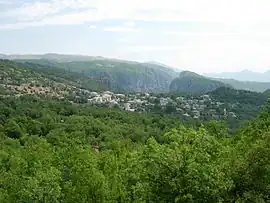Monodendri
Μονοδένδρι | |
|---|---|
 Monodendri | |
 Monodendri | |
| Coordinates: 39°53′N 20°45′E / 39.883°N 20.750°E | |
| Country | Greece |
| Administrative region | Epirus |
| Regional unit | Ioannina |
| Municipality | Zagori |
| Municipal unit | Central Zagori |
| Elevation | 1,060 m (3,480 ft) |
| Population (2011)[1] | |
| • Rural | 129 |
| Time zone | UTC+2 (EET) |
| • Summer (DST) | UTC+3 (EEST) |
| Vehicle registration | ΙΝ |
Monodendri (Greek: Μονοδένδρι) is a village in the Ioannina regional unit (Epirus region) in Greece. It is part of the municipal unit of Central Zagori in the Zagori region, and is located 41 kilometres (25 mi) north of the city of Ioannina.
Monodendri is built at a height of 1,060 meters (3,480 ft) and retains much of the traditional stone-built architecture.
History
The name "Monodendri" (meaning "lonely tree" or "single tree") came into use only in the beginning of the 19th century. Its origin is in a very large tree, whose remains still existed in 1910. The village was previously considered a neighbourhood of Vitsa.[2]
As with the other Zagori villages, Monodendri enjoyed an extended period of commercial and economic prosperity during the 17th and 18th centuries. There were schools built, churches in the Byzantine style and luxurious stone manors (Greek: Αρχοντικά). The first school, the Scholarcheion, was`founded in 1750.[3] In the school taught among others Paparousis, who later in 1814 taught in the Academy of Bucharest and in Vienna, where he published an article on Physical Science in Logios Hermes (Hermes ho Logios).[4] In the Scholarcheion also taught the renowned Neophytos Dotos (1814–18) and Anastasios Sakellarios from 1825 to 1830, when he left to direct the new Zosimaia School in Ioannina. The school is said to have had also some distinguished students, among them Georgios Gennadios and the revolutionary leader Markos Botsaris from Souli.
Monodendri was the birthplace of the merchants and national benefactors Manthos and Georgios Rizaris, and of Angelos Kitsos (former president of the Rizarios Foundation). There were three schools in Monodendri in the 19th century, a primary school (“Ellinikon” or Common School of Greek Studies (Greek: Κοινή Σχολή Ελληνικών Μαθημάτων) founded by the brothers Manthos and Georgios Rizaris in 1835) and housed in their original home, an Allelodidaktikon (high school) and a school for girls, the Parthenagogeion, also founded by the Rizaris brothers in 1841.[5]
Orthodox Albanians, locally called "Arvanites", have settled the village after the 15th century, later assimilating into the local population. Sarakatsani have settled at the beginning of the 20th century.[6]
Monodendrites usually immigrated to Macedonia and Southern Greece. Outside Greece, they immigrated to Egypt, Romania, Asia Minor, Africa and the United States.[2]
Architecture
The church of Aghios Athanasios, in the middle of the central square, is of significant historical value. The bequests of the Rizari brothers are visible in the village today, and include the Rizarios Exhibition Center, the Rizarios Handicraft School and the primary school. The amphitheatrically built stone theater, in the village end, is used for cultural festivals during the summer months.
The monastery of St Elias dates from the period of the foundation of Monodendri at the turn of the 15th century. From the same time dates also the church of St George (Agios Georgios).[5] Georgios Gennadios and Markos Botsaris were during their childhood students at the monastery of St Elias.[5]
Near the village lies the historic monastery of Agia Paraskevi, built on the edge of the Vikos Gorge. The monastery was founded in 1412 by Michael Voevodas Therianos and the people of Vitsa, as stated on an inscription,[7] during the reign of Carlo I Tocco. It was a property of the monastery of St Elias but was refounded as a nunnery in 1778. The panoramic view from the monastery is spectacular.
Because of its scenery and traditional architecture Monodendri attracts some tourism, especially during the Christmas period.
Notable Monodendrites
- The national benefactors Manthos and Georgios Rizaris, founders of the Rizareios Foundation in Athens in 1841 and of the Rizareios Ecclesiastical School in 1844, while Monodendri was still under Ottoman rule.
- Ioannis Koniaris, mayor of Athens in the 19th century.
- Dimitrios Semitelos (1828–1898), scholar.
- Anastasios Tagis (1839-1900), scholar and teacher.
See also
External links
Bibliography
- Kahl, Thede (1999). "Die Zagóri-Dörfer in Nordgriechenland: Wirtschaftliche Einheit – ethnische Vielfalt". Ethnologia Balkanica. 3.
References
- ↑ "Απογραφή Πληθυσμού - Κατοικιών 2011. ΜΟΝΙΜΟΣ Πληθυσμός" (in Greek). Hellenic Statistical Authority.
- 1 2 A. Kathareios (Inspector of the 1st educational region of Epirus) Report of Inspection of Zagorochoria in 1913
- ↑ Ioannis N Vadsdekis (Superintendent of the Rizareion School of Monodendri) Το "Ριζάρειο" Δημοτικό Σχολείο Μονοδενδρίου από το 1750 ως το 2010, Το Ζαγόρι μας, Issue 386, page 5, August 2010.
- ↑ Issues of the journal Hermes ho Logios (Ερμής ο Λόγιος), Österreichische Nationalbibliothek
- 1 2 3 Λαμπρίδης Ιωάννης "Ζαγοριακά", Τυπογραφείον Αυγής, Αθήνα, 1870
- ↑ Kahl 1999, p. 106,114: "Ansiedlungen christlich-orthodoxer Albaner (sog. Arvaniten)..."
- ↑ "Archived copy" (PDF). www.nomioan.gr. Archived from the original (PDF) on 28 November 2006. Retrieved 22 May 2022.
{{cite web}}: CS1 maint: archived copy as title (link)